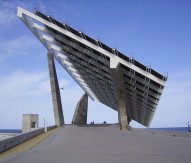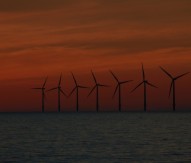
Wind energy technology “key” in H2020
An overarching theme in Horizon 2020 is to encourage sustainable economic growth, create more skilled jobs and invest in research and development. One objective of the Societal Challenges pillar of the EU’s next research framework programme is ‘Secure, clean and efficient energy’.
As the European Wind Energy Association’s regulatory affairs adviser, Vilma Radvilaitė has been closely following developments regarding Horizon 2020. However, she is now worried that budgetary constraint by member states could affect the long-term investment in this green energy source.
One of the key goals of Horizon 2020 is to help generate economic growth and jobs. Do you think the EU is now recognising the real economic potential of the wind energy industry?
The Commission has identified wind energy as one of the key strategic energy technologies. In 2010, the European Industrial Initiative on Wind Energy (EWI) was launched by the Commission, member states and the wind energy industry with a goal to develop wind technology to bring a substantial share of clean electricity to the European energy market as well as significantly reduce the cost of electricity. It is a ten-year research and development plan for wind energy technology.
The Commission expects wind energy will be one of the main electricity generating technologies of the 2050 Energy Roadmap and will provide between 31% and 48% of electricity production in Europe. This gives the wind energy industry huge potential in Europe. However, as a sector we feel that the technology needs to be supported by public finances as well as by stable regulatory frameworks and binding 2030 renewable energy targets. Horizon 2020 will show whether European politicians really want to commit to the development of this technology.
In the Commission’s proposal, wind is one of the main technologies to provide low cost, low carbon electricity in Horizon 2020. Yet in budgetary terms, it’s still very difficult to see what money the sector will receive. For the moment, we can only hope that the Horizon 2020 budget will not be cut as drastically as we have seen in some other areas.
It’s been announced though that the research and innovation framework programme could receive nearly €10bn less in funding than proposed by the Commission. What potential effect could this have on the sector?
The €6bn proposal for energy research and development under Horizon 2020 reflects the overall budgetary increase for research, but not a new, bigger role for energy. For the wind sector, the industry is counting on more than €1bn of EU research funding according to the EWI while industry is going to contribute with twice as that.
The sector faces a lack of dedicated funding allocations from EU institutions. It’s very important the Commission provides a financial signal and allows dedicated funding for wind energy research and development. The recent Council cuts of the overall research budget is a worrying development as it’s a key part of the European budget and these cuts are not a good signal for industry.
I think that if we assume the overall budget for Horizon 2020 is €70bn, that means a reduction of 12.5% compared to the Commission’s proposal. That would mean that the non-nuclear energy part will get around €5bn instead of €6bn, unless there is reprioritisation.
Do you think that is likely?
Personally, I think energy is extremely important. If we want to avoid Europe importing fuel and to keep technologically ahead, particularly in wind energy, we need to have a very strong and world-leading technological base. If Europe wants to keep that, I would say that prioritising energy technology R&D funding is very important.
What impact will Horizon 2020 have on increasing investor confidence in the wind energy sector?
First, I would like to see the final numbers. However, we can already say that the share of public funding for wind energy R&D will not be as big as we would like. One of our requests is funding for the implementation of the EWI. That way, the industry would see a financial commitment from European institutions to develop wind energy technology. This would be a very positive signal for private investors, whilst also providing good results in developing technology. The technology is still very risky and private investors are sometimes reluctant to invest in the technology and finance projects.
So given the right regulatory framework, financial commitment and political statements which favour wind energy as one of the key technologies, we urge European institutions to follow up their political statements with financial allocations.
A key focus for Horizon 2020 is bringing more new, concrete products to market. What results do you think we could potentially see from the wind energy sector?
The EWI is the main technological development plan for the wind industry until 2020. According to the EWI, the objective is to make onshore wind the most competitive energy source by 2020 and offshore wind the most competitive energy by 2030. Other goals to achieve by 2020 include 20% of EU electricity consumption coming from wind and the creation of 250,000 new skilled jobs. These objectives are very ambitious. However, we believe we could achieve a lot if we have a stable regulatory framework and European financial commitments are translated into actual funding – this would give the right message to industry and private investors.
I still believe the wind industry will keep investing in the development of new technology. However, reducing the budget available for energy research, and for research in general, is clearly a worrying message from politicians. Europe should really invest and put public money in the policy areas which create jobs and encourage innovation. I think the Commission proposal was pointing to that. However, in their negotiations, member states have kept to old traditions of budgetary restraint.
In terms of concrete technological developments by 2020, we hope to see 15-20MW offshore wind turbines, low-wind-speed machines, floating structures for offshore wind turbines and in general less costly, more effective and reliable turbines.
What impact do you think a potential move away from nuclear technology would have on the wind energy industry?
Wind energy has developed significantly in the last few years, even though nuclear still has a big role in the energy mix. During the last decade (2000-2010) wind represented a 28% share of the new EU power capacity, compared to just 1% for nuclear. However, I wouldn’t say reducing the use of one technology would automatically benefit another as the technology has to prove to be good and promising; but also a positive political climate is very important for the energy technology to develop.
We see though a very big gap between European R&D funding for nuclear energy technology and non-nuclear technologies. In the last 20 years in the European framework programme for research, nuclear has received €12bn for R&D activities whilst wind energy has received between €350m-€380m. We would like to see more equal treatment from the Commission, especially considering the 2050 Energy Roadmap where we expect wind will be a key energy generating technology.
The Multiannual Financial Framework and Horizon 2020 are not yet finalised, so this gives us the opportunity to remind the European Parliament, as well as member states, that if Europe is willing to move on from the current economic situation, boost growth and create skilled jobs, they should rethink how the EU budget meets these goals. I hope we will see some positive changes.
Vilma Radvilaitė


